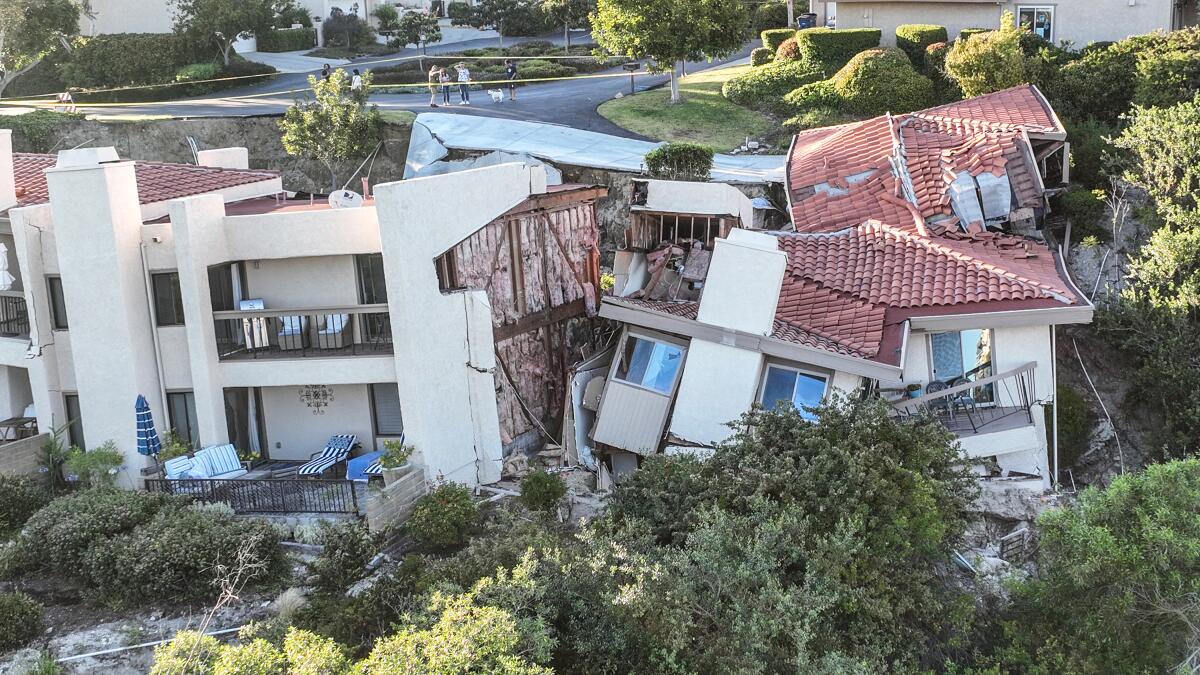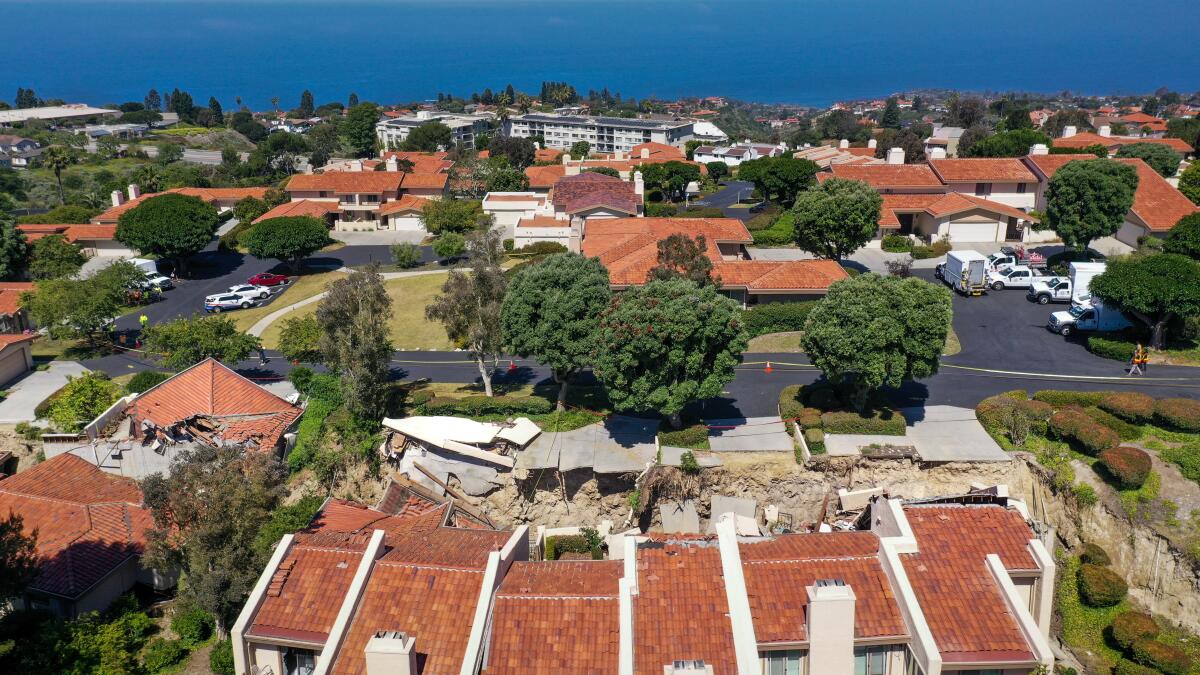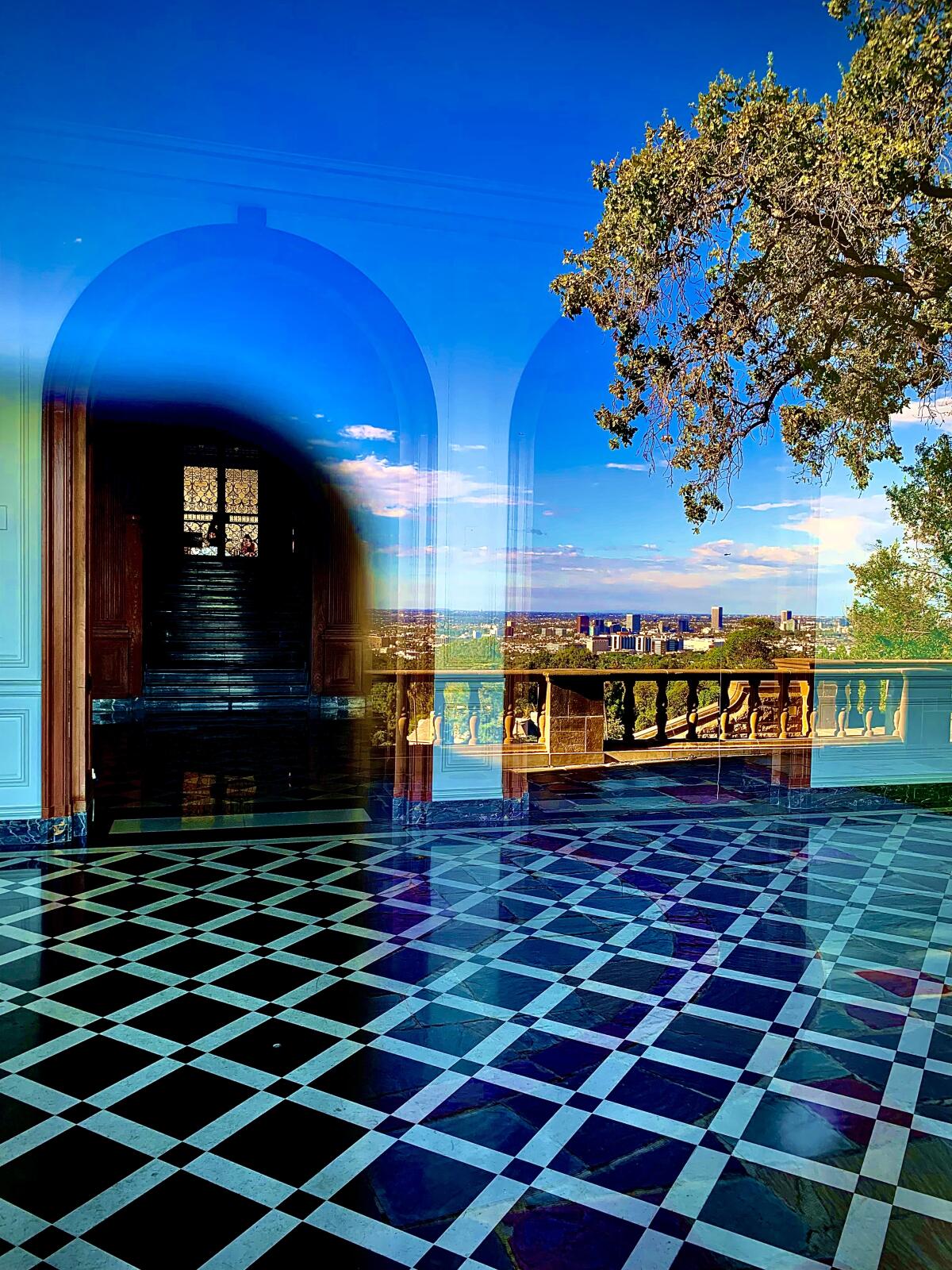Rolling Hills Estates landslide highlights Southern California’s risk

- Share via
Good morning, and welcome to the Essential California newsletter. It’s Wednesday, July 12.
Residents in the small Los Angeles County city of Rolling Hills Estates are on edge and waiting for answers after a major landslide caused a dozen townhomes to begin sliding downhill.
The landslide was first reported Saturday, leading to evacuations as some homes appeared to be visibly leaning. Since then, officials said at least eight of the multimillion-dollar properties have been totally ruined as the shifting earth and gravity continue to pull the structures downhill.
“It’s still unclear what caused the landslide in the community, which is on the southwestern side of the Palos Verdes Peninsula,” my colleagues Grace Toohey and Nathan Solis reported Tuesday. “Still, the landslide is not entirely surprising to geologists who understand the makeup of the land ... and the history of the region.”

According to data from the U.S. Geological Survey, the region’s land consists of shallow marine sediments, soft siliceous sedimentary mudstone and shale — many of which can shift with changes in weight load and pressure.
City officials expressed surprise at the destruction, saying there had been no geological issues in the area in decades. But as Colin Robins, associate professor of environmental science at Claremont McKenna College, told The Times, geologic time and human time are worlds apart:
“Our lives are relatively short. We don’t understand that something in a hazard area can very easily sit there for years and appear fine by all outward appearances, until suddenly the stresses that have been active all along suddenly reach their breaking point.”
Landslides can be caused by natural events like earthquakes or rain, or by human-made disturbances to land. It probably won’t come as a shock that hilly and mountainous terrain is often susceptible to landslides. And Southern California has a lot of that.
The hilly Palos Verdes Peninsula has a history of landslides, with some areas still deemed active. This map compiled by the California Department of Conservation plots dozens of active or dormant landslides recorded over the last 30 years — though officials note their inventory “is a work in progress.”

That map is one of two department officials say can help people discern which areas are most at risk for landslides triggered by storms or earthquakes.
If that first map raises your eyebrows, you really won’t like the other one, which shows the susceptibility of deep-seated landslides across California.
Darker red areas represent places with a higher “relative likelihood of future landsliding based solely on the intrinsic properties of a locale or site,” with previous landslides, rock and soil strength and slope steepness as the key factors. And there’s a lot of dark red.
The map also includes burn zones from recent wildfires, which further weaken already susceptible slopes and increase the risk of landslides.
With climate change intensifying the extreme weather whiplash of severe fires and heavy rains, Southern California is primed to experience landslides more frequently, U.S. Geological Survey researchers found in a recent study.
It’s not my intention to scare you first thing in the morning, but exploring this state data is humbling, if not a little anxiety-inducing. Most of us probably don’t think of it much, but there’s a lot happening under our feet. That’s a reality for which developers, residents and public officials will have to better prepare for as our slices of paradise become more likely to crumble away.
And now, here’s what’s happening across California:
Note: Some of the sites we link to may limit the number of stories you can access without subscribing.
L.A. STORIES
Some signage is causing a stir in Malibu. A state preservation agency posted signs directing visitors to a local beach, which city workers later took down. Malibu officials said the signs didn’t meet code requirements, but state workers accuse the city of intentionally trying to hide the public beaches from the public. Los Angeles Times
L.A. City Attorney Hydee Feldstein Soto expressed regret for putting the Skid Row Housing Trust in the hands of a man who misrepresented his ability to manage the properties and care for poor tenants. Turns out that man, Mark Adams, and his associates gave at least $8,500 to her election campaign. Los Angeles Times
In the wake of 2020’s nationwide swell of racial justice demonstrations, Hollywood pledged to invest in diversity initiatives. But last month, the Black diversity chiefs at Walt Disney Co., Netflix and the Academy of Motion Picture Arts and Sciences all resigned or were forced out. Companies have started to scale back on those earlier commitments, Times reporters Greg Braxton and Meg James wrote, “leading some insiders and advocates to fear that the doors to more opportunities once again have been slammed shut.” Los Angeles Times
Free online games
Get our free daily crossword puzzle, sudoku, word search and arcade games in our new game center at latimes.com/games.
POLITICS AND GOVERNMENT
How do more sick days and family leave sound? A slate of bills being considered by state lawmakers seek to improve Californians’ work-life balance, though some opponents say the rules would overburden small businesses. CalMatters
As state leaders weigh possible reparations for Black Californians, some Indigenous Californians are speaking up and seeking inclusion in discussions about restitution. Times reporter Tyrone Beason asks: “Is it futile for Native Americans to expect that California will compensate them for all that was taken, as it will consider doing for Black residents?” Los Angeles Times
CRIME, COURTS AND POLICING
Former Manson family member Leslie Van Houten has been released from prison days after Gov. Gavin Newsom announced he would not challenge a California appellate court’s decision to grant her parole. Van Houten, 73, has spent more than 50 years in prison for her involvement in the 1969 murders of Leno and Rosemary LaBianca. Los Angeles Times
Nearly three dozen L.A. County Sheriff’s deputies won’t have to show any ink to Inspector General Max Huntsman. A judge issued an injunction blocking Huntsman’s attempt to require 35 deputies to reveal any gang tattoos they might have as part of the investigation into deputy gangs operating out of sheriff’s stations. LAist
Cedars-Sinai Medical Center is under a federal civil rights investigation after allegations of racism and discrimination in the hospital’s treatment of Black mothers. That follows a pair of lawsuits filed by the husband of Kira Dixon Johnson, a Black woman who died after a caesarean section at the hospital in April 2016. Los Angeles Times
Support our journalism
HEALTH AND THE ENVIRONMENT
A new state law took effect this month, aimed at protecting climate-threatened Joshua trees by imposing fees to remove the iconic yuccas to build renewable energy infrastructure and housing. Some opponents of the new rules say it will stifle development and economic growth. Los Angeles Times
The effects of climate change are a daily reality for farmworkers in California’s Central Valley. But the majority Latino workforce — many of them without documentation — lack protection in the face of extreme heat, wildfires and hazardous smoke, plus recent flooding that’s devastated communities. KQED
AND FINALLY
Today’s California landmark is from Elyse Jankowski of Los Angeles: Beverly Hills’ highly Instagrammable Greystone Mansion.

Elyse writes:
Greystone Mansion is an iconic nearly-100-year-old estate in Beverly Hills. It was listed in the National Register of Historic Places in 1976 and in 2013 was designated Beverly Hills Local Historic Landmark No. 4. It’s open to the public, and the grounds are full of Instagrammable scenes.
What are California’s essential landmarks? Fill out this form to send us your photos of a special spot in California — natural or human-made. Tell us why it’s interesting and what makes it a symbol of life in the Golden State. Please be sure to include only photos taken directly by you. Your submission could be featured in a future edition of the newsletter.
Please let us know what we can do to make this newsletter more useful to you. Send comments to essentialcalifornia@latimes.com.
Sign up for Essential California
The most important California stories and recommendations in your inbox every morning.
You may occasionally receive promotional content from the Los Angeles Times.







